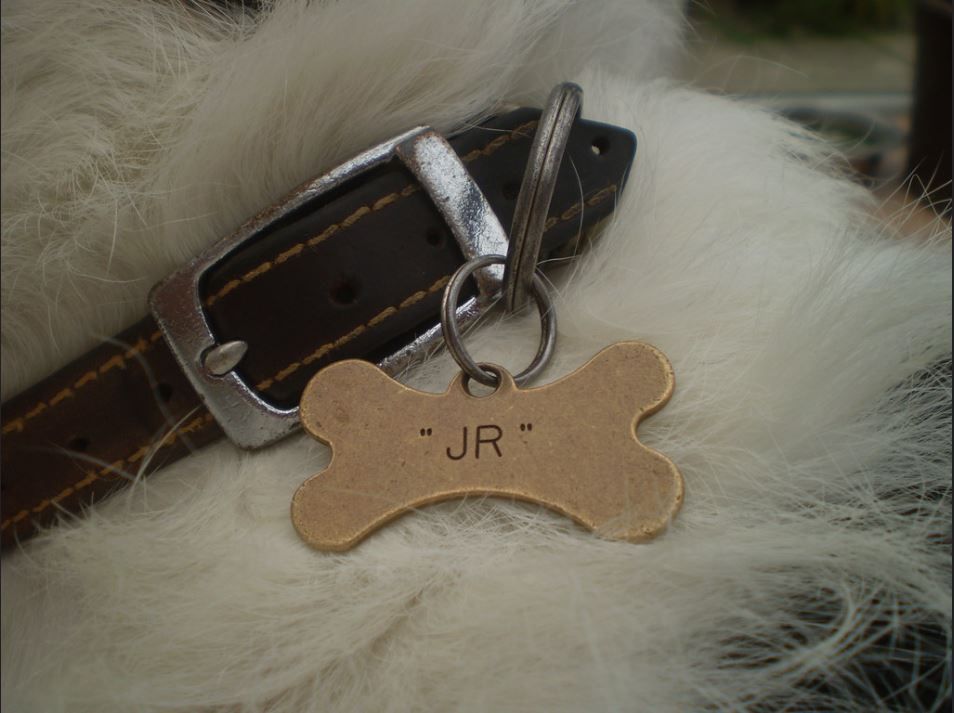Ensuring that your dog has a name tag on their collar is essential for their safety and well-being. A name tag serves as a form of identification and can be crucial in reuniting you with your furry friend if they ever go missing. It provides important information such as your contact details, which can help others reach out to you if necessary.
There are various types of dog name tags to choose from, each with its own advantages. Traditional metal name tags are durable and commonly used. Personalized embroidered name tags add a touch of uniqueness and can include additional information. QR code name tags offer a modern solution, allowing anyone with a smartphone to scan the code and access your pet's information online.

Putting a Dog Name Tag
Putting a dog name tag on a collar is a simple process that can be done at home. Here are the steps to follow:
Step 1: Choose a suitable collar that fits your dog comfortably.
Step 2: Select the right size name tag that is visible and readable.
Step 3: Prepare the necessary items such as the name tag, collar, and a small split ring or S-hook.
Step 4: Attach the name tag to the collar by sliding the ring or hook through the tag's hole and looping it around the collar's D-ring.
Step 5: Ensure that the name tag is securely fastened and does not easily come off.
In addition to properly attaching the name tag, there are a few extra tips to keep in mind. Regularly check the name tag's condition to ensure it remains legible and free from damage. Update the information on the name tag if your contact details change to ensure its effectiveness. It is also worth considering microchipping your dog as a backup form of identification, as microchips provide a permanent and unalterable means of identification.
By following these steps and tips, you can provide your dog with a reliable and easily identifiable name tag, offering peace of mind knowing that their identification is readily available.
Why Does Your Dog Need a Name Tag?
Dogs require a name tag for numerous significant reasons.
First and foremost, a name tag is fundamental for providing identification for your beloved pet. In the unfortunate event that your dog goes missing, a name tag containing your contact information can greatly increase the chances of a speedy and safe return. This uncomplicated and efficient method enables anyone who finds your dog to easily get in touch with you.
Moreover, a name tag can act as a form of legal documentation. Many jurisdictions mandate that dogs must wear a name tag showcasing their owner's contact details. By adhering to this requirement, you are demonstrating your responsibility as a dog owner and minimizing the risk of encountering any legal complications.
Additionally, a name tag can also convey essential medical information. If your dog has specific health conditions or allergies, including such crucial details on the tag can be crucial in case of an emergency. It enables individuals like veterinarians or animal control officers to promptly and accurately address your dog's specific needs.
Furthermore, a name tag helps establish a sense of ownership. It serves as a clear indication that your dog is well-cared for and has someone responsible for their overall well-being. This can act as a deterrent for theft or any misunderstandings regarding ownership.
Ultimately, a name tag is a straightforward yet indispensable accessory for your canine companion. It not only provides identification but also ensures legal compliance, conveys medical information, and solidifies a sense of ownership. By ensuring that your dog wears a name tag, you are taking proactive measures to guarantee their safety, well-being, and your own peace of mind.

Types of Dog Name Tags
When it comes to dog name tags, there's a variety of options to choose from. From classic metal tags to personalized embroidered ones, and even high-tech QR code tags, each type offers unique features and benefits. In this section, we'll dive into the different types of dog name tags, exploring what makes them stand out and why they may be the perfect fit for your furry friend. So, let's unravel the world of dog name tags and find the perfect match for your pup!
1. Traditional Metal Name Tags
Traditional metal name tags are a popular choice for dog owners who want a reliable and long-lasting option. Here are the key features and benefits of:
- Durability: Traditional metal name tags, such as stainless steel or brass, are made of high-quality materials that can withstand daily wear and tear.
- Visibility: These name tags made of metal offer excellent visibility, making it easy to read the engraved information even from a distance.
- Customization: Most traditional metal name tags can be engraved with important details like the dog's name, the owner's contact information, and any other relevant information.
- Versatility: These name tags come in different shapes and sizes, giving dog owners the option to choose the one that best suits their preferences and their dog's collar.
- Ease of use: Traditional metal name tags can be easily attached to a dog's collar using a ring or a clip, ensuring a secure fit and preventing the tag from getting lost.
- Cost-effectiveness: Metal name tags are often more affordable compared to other personalized options, making them a practical choice for dog owners on a budget.
- Longevity: Due to their durable nature, metal name tags can last for a long time without significant wear or fading, providing continued identification for the dog.
When choosing a traditional metal name tag, it is essential to consider the size, shape, and design that best suits your dog's collar and personality. Regularly check the name tag's condition to ensure its legibility and update the information if needed.
Consider microchipping as a backup identification method for added security. With a traditional metal name tag, you can provide your dog with a reliable and visible form of identification that will help them stay safe.
2. Personalized Embroidered Name Tags
Personalized embroidered name tags are a popular option for dog owners. They offer a unique and customized look for your furry friend. Here are some key points to consider:
- Customization:
Personalized embroidered name tags, like the ones we offer, allow you to have your dog's name and your contact information directly embroidered onto the tag. This ensures that the information is clear and easy to read.
- Durability:
Our personalized embroidered name tags are made with high-quality materials, such as durable nylon or polyester, which ensures they can withstand the wear and tear of everyday use. The embroidery is also strong and long-lasting.
- Easy to read:
The embroidery on our personalized name tags is typically done in a contrasting color to the background, making it easy to read even from a distance. This is especially helpful if your dog tends to wander or gets lost.
- Stylish:
Our personalized embroidered name tags come in a variety of colors, designs, and font styles, allowing you to choose one that matches your dog's personality or your own personal taste.
- Comfort:
Our personalized name tags are usually lightweight and don't have any sharp edges, ensuring they don't cause any discomfort or irritation to your dog's neck.
- Easy maintenance:
Our personalized embroidered name tags are easy to clean and maintain. You can simply wipe them down with a damp cloth or gentle cleaning solution to remove any dirt or grime.
Personalized embroidered name tags, such as ours, are a great option if you're looking for a durable, easy-to-read, and stylish way to identify your dog. They offer a level of customization that can help your dog stand out and ensure their safety.

3. QR Code Name Tags
QR Code Name Tags are a modern and innovative way to provide identification for your furry companion. They combine traditional tags with advanced technology to offer additional benefits. Here is a table highlighting the features of QR Code Name Tags:
| Features | Details |
|---|---|
| Functionality | QR Code Name Tags can be scanned using a smartphone or QR code reader. |
| Easy to Update | The information stored in the QR code can be easily updated in case of any changes. |
| Personalized | QR Code Name Tags can be customized with your pet's name, your contact information, and other important details. |
| Quick Access to Information | When scanned, QR codes provide instant access to vital information, such as your pet's name, your contact number, and medical details. |
| Increased Safety | QR Code Name Tags enhance the chances of reuniting with your lost pet by providing quick and accurate identification. |
Using QR Code Name Tags has several advantages, including convenience, ease of updating information, and immediate access to critical details. They are perfect for pet owners who want to ensure their furry friends are easily identifiable and can be quickly returned if lost.
Incorporating a QR Code Name Tag into your pet's collar is a simple yet effective way to provide added safety and peace of mind. So why wait? Explore the world of QR Code Name Tags and give your pet the best possible identification option.
Steps to Put a Dog Name Tag on a Collar
Looking to add a name tag to your dog's collar? Let's break it down step by step. We'll cover everything from selecting the right collar to ensuring the name tag is securely attached. So, whether you're a new pet owner or simply need a refresher, these simple steps will have your furry friend sporting their personal identification in no time! No more worrying about lost or misplaced collars. Let's get started on this quick and easy process!
Step 1: Choose a Suitable Collar
When it comes to putting a name tag on your dog, the first step is to choose a suitable collar. Here are the steps you should follow:
- Measure your dog's neck:
Use a flexible tape measure to determine the circumference of your dog's neck. Make sure to measure around the widest part of the neck.
- Consider your dog's size and breed:
Different breeds and sizes of dogs require different types of collars. For example, small breeds may do well with lightweight fabric collars, while larger breeds may need sturdier leather or nylon collars.
- Assess your dog's behavior and needs:
If your dog is prone to pulling or has a tendency to slip out of collars, you may need to choose a collar with additional features like a martingale or a harness. Take into account any specific needs or preferences your dog may have.
- Choose the appropriate width:
The width of the collar should be proportional to your dog's size. Smaller dogs typically require narrower collars, while larger dogs need wider collars for better support and comfort.
- Consider the collar's fastening mechanism:
Collars can have different types of fastenings, such as traditional buckle closures or quick-release buckles. Choose a fastening mechanism that is secure and easy to use.
- Select a style that suits your taste:
Collars come in various styles, colors, and patterns. Choose a collar that reflects your dog's personality and matches your preferences.

Step 2: Select the Right Size Name Tag
- Measure your dog's collar width:
Use a measuring tape or ruler to determine the width of your dog's collar. This measurement will help you select the right size name tag that fits securely onto the collar without being too loose or too tight.
- Consider your dog's size and breed:
Different breeds have different collar sizes. Consider the size of your dog and select the right size name tag that is proportionate to their collar size. For larger dogs, a larger name tag may be suitable, while smaller dogs may require a smaller tag.
- Check weight and thickness:
The weight and thickness of the name tag can affect your dog's comfort. A heavy or thick tag may cause unnecessary discomfort or irritation. Choose a name tag of the right size that is lightweight and has a suitable thickness to ensure your dog's comfort while wearing it.
- Ensure legibility:
The size of the name tag should allow for clear and legible text. Avoid choosing a tag that is too small, as it may be difficult to read the information. Select the right size name tag that balances the size of the tag with the necessity of providing all the necessary information.
- Consider attachments:
Some name tags come with attachments such as a split ring or lobster clasp. Make sure the size of the attachment is appropriate for your dog's collar and allows for easy attachment and removal of the tag.
Remember, it's always a good idea to regularly check the condition of the name tag and update the information if necessary. Consider microchipping your dog as a backup form of identification for added security.
Step 3: Prepare the Necessary Items
To prepare the necessary items for putting a dog name tag on a collar, follow these steps:
1. Gather the required materials, including a dog collar, a dog name tag, and the necessary attachments such as split rings or S-hooks.
2. Clean the collar and name tag to remove any dirt or debris. Use mild soap and warm water to clean them thoroughly. Rinse and dry them completely before proceeding to the next step.
3. If customization is required for the name tag, such as engraving or embroidery, provide the necessary information to the manufacturer or service provider. Specify the desired font, text, and any additional design elements.
4. Double-check the spelling and accuracy of the information to ensure that the name tag will display the correct details. This includes the dog's name and your contact information, such as your phone number or address.
5. Inspect the attachments, such as split rings or S-hooks, to ensure they are in good condition and will securely attach the name tag to the collar.
6. If necessary, assemble the attachments onto the name tag by sliding them through the designated holes or loops. Make sure they are tightened securely.
7. Place the name tag on the collar in the desired position. Determine if you prefer it to be centered or positioned closer to the buckle end.
8. Attach the name tag to the collar by threading the split rings or S-hooks through the holes or loops on the collar and the name tag. Use pliers or your fingers to secure them tightly.
9. Ensure that the name tag is securely fastened to the collar by giving it a gentle tug. It should not easily slide or come loose.
By following these steps, you can effectively prepare the necessary items for putting a dog name tag on a collar.
Step 4: Attach the Name Tag to the Collar
- Choose a suitable collar
- Select a collar that fits your dog comfortably and securely. Ensure that it is the appropriate size and material for your dog's needs.
- Select the right size name tag
- Pick a name tag that is proportionate to the size of your dog and the collar. The tag should be large enough to accommodate your dog's name and contact information.
- Prepare the necessary items
- Gather the name tag, a split ring or a quick-release buckle, and any other accessories needed for attaching the tag to the collar.
- Attach the Name Tag to the Collar
- Slide the split ring or quick-release buckle through the hole or loop on the name tag. Then, thread it onto the collar and ensure that it is securely fastened.
- Ensure the name tag is secure
- Double-check that the name tag is securely attached to the collar. Give it a gentle tug to ensure it does not come loose easily.
By following these simple steps, you can securely attach the name tag to your dog's collar, ensuring that their identification information is easily visible and accessible in case they become lost or separated from you.

Step 5: Ensure the Name Tag is Secure
- After attaching the name tag to the collar, gently tug on it to ensure it is securely fastened. The name tag should not easily slide or come off when pulled with moderate force.
- Check if there are any sharp edges or rough surfaces on the name tag that could potentially harm your dog or cause discomfort. Smooth out any sharp edges using a file or sandpaper.
- Regularly inspect the name tag and collar for any signs of wear and tear. Over time, the attachment hardware or the engraving on the name tag may become loose or damaged. If necessary, replace the name tag or repair any issues to maintain its security.
- Consider using additional methods to secure the name tag, such as using a split ring or a collar slide to prevent accidental detachment. These can provide an extra layer of security and minimize the risk of losing the name tag.
- Ensure that the name tag is visible and not obstructed by fur or other accessories. This will make it easier for people to read the information on the tag and contact you if your dog gets lost.

Fact: According to a study conducted by the American Society for the Prevention of Cruelty to Animals (ASPCA), dogs with identification tags are more likely to be reunited with their owners compared to those without tags. Ensuring the name tag is secure is crucial for increasing the chances of a lost dog being returned safely.
Conclusion:
In summing up, ensuring your dog has a properly attached name tag on its collar is not just about following guidelines or showcasing a stylish accessory; it's a critical step towards safety and assurance. A well-maintained, visible name tag can make all the difference in reuniting lost pets with their owners.
Moreover, as responsible pet guardians, it's our duty to ensure our dog's identification is up-to-date and legible. While name tags serve as an immediate source of identification, considering further measures like microchipping offers an added layer of security. By combining these methods, we fortify our commitment to the well-being and safety of our canine companions.
Frequently Asked Questions
1. How should I attach my dog's name tag to its collar?
You can attach your dog's name tag to its collar using various options. One popular method is using split ring attachments, which are easy to use and provide security. Another option is to use plates that can be riveted into the collar, similar to a halter plate.
2. Are S-hooks a safe option for attaching dog tags?
While S-hooks are a popular method for attaching dog tags, they can pose a hidden danger if not pinched shut completely. They have the potential to catch on things and harm your dog. It is important to ensure that both sides of the S-hook are completely closed to eliminate this risk.
3. How can I prevent my dog's ID tags from constantly jangling?
If you find the constant jangle of hanging dog tags to be frustrating, one option is to use boomerang tags. These tags are designed to eliminate noise as they attach flush to the collar. Another suggestion is to use rubit clips, which securely hold the tags in place while eliminating the noise.
4. Is there a better way to switch ID tags between different collars?
Yes, using a Klippy can make it easier to transfer the ID tag between different collars. The Klippy uses a split ring to attach the tag and acts like a miniature climber's clip, allowing for easy clipping and unclipping of the tag. It is convenient when switching between collars or removing the tag when necessary.
5. How do I ensure the strength and durability of the tag attachment?
When choosing a method to fasten tags to your dog's collar, it is important to consider the strength and springiness of the attachment. Tug testers can be used to determine the amount of pull a split ring or other type of tag attachment can withstand without bending or shattering. This ensures the attachment can hold up to the daily activities of your dog.
6. Can I use split ring attachments for other purposes?
Yes, split rings can be versatile and used for various purposes. Many people have found other uses for split rings, such as attaching keys or other small items. The strength and ease of use of split rings make them suitable for holding stuff beyond just your dog's ID tags.






